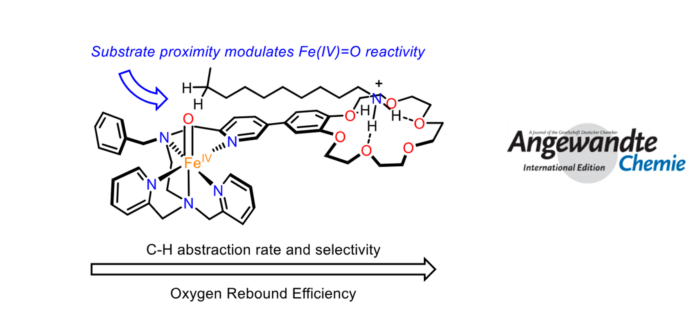Precise control of substrate positioning and orientation (its proximity to the reactive unit) is often invoked to rationalize the superior enzymatic reaction rates and selectivities when compared to synthetic models. Artificial nonheme iron (IV) oxo (Fe(IV)=O) complexes react with C(sp3)-H bonds via a biomimetic Hydrogen Atom Transfer/Hydroxyl Rebound mechanism, but rates, site-selectivity and even hydroxyl rebound efficiency (ligand rebound versus substrate radical diffusion) are smaller than in oxygenases. Herein, we quantitatively analyze how substrate binding modulates nonheme Fe(IV)=O reactivity by comparing rates and outcomes of C-H oxidation by a pair of Fe(IV)=O complexes that share the same first coordination sphere but only one contains a crown ether receptor that recognizes the substrate. Substrate binding makes the reaction intramolecular, exhibiting Michaelis-Menten kinetics and increased reaction rates. In addition, C-H oxidation occurs with high site selectivity for remote sites. Analysis of Effective Molarity reveals that the system operates at its maximal theoretical capability for the oxidation of these remote sites. Remarkably, substrate positioning also affects Hydroxyl Rebound, whose efficiency increases only on the sites placed in proximity by recognition. Overall, these observations provide evidence that supramolecular control of substrate positioning can effectively modulate the reactivity of oxygenases and its models.
This work has been led by Prof. Miquel Costas in collaboration with Prof. Stefano Di Stefano and Dr. Giorgio Olivo (Sapienza University of Rome).
It has been recently published open access in Angewandte Chemie International Edition:
A. Fagnano, F. Frateloreto, R. Paoloni, C. Sappino, O. Lanzalunga, M. Costas*, S. Di Stefano*, G. Olivo*
“Proximity Effects on the Reactivity of a Nonheme Iron (IV) Oxo Complex in C-H Oxidation“
Angew. Chem. Int. Ed.., 2024, e202401694
DOI: 10.1002/anie.202401694
Girona, April 2nd, 2024
For more info: ges.iqcc@udg.edu

